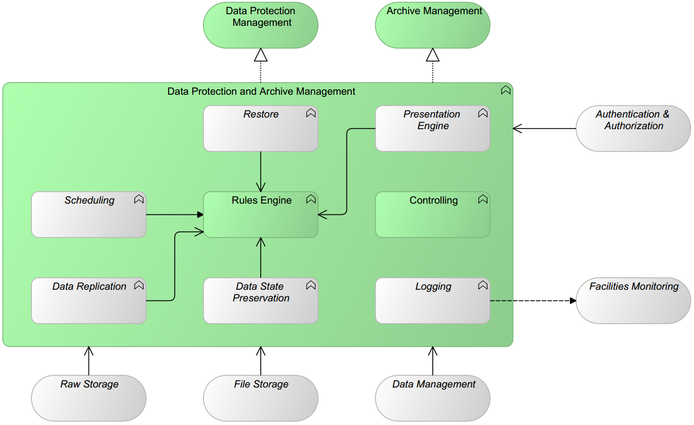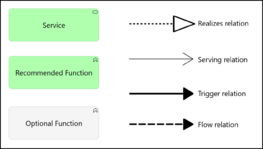GP.Data Protection+Archive Management
| Page maturity This page has maturity level 2 (young) |
| GP | Data Protection & Archive Management | Version: | 0.1 | 
| |
|---|---|---|---|---|---|
| Document type: | Generic Pattern | Owner: |
| This Pattern can help to realize a level of data protection for sets of data and/or convert these sets into archives. |
Description
This Generic Pattern belongs to "Operations". This Pattern contains the main functionality required to realize a level of data protection for sets of data and/or convert these sets into archives. For this, the Pattern mainly relies on a Rules Engine that controls all actions concerning the creation of backups and archives, as well as actions concerning the restoring of a backup or consultation of an archive. Note that functionality surrounding the management of backup and archive metadata is not included in the Pattern, nor is the functionality surrounding the storage of the rules processed by the Rules Engine - however, these can be provided by an instance of adjacent Pattern Data Management. In order to create the backups and archives, the Data Replication function is used. When using this function, the question is if the data replicated remains at the original location, in which case the action results in a backup, or is deleted, in which case the data is effectively migrated, and results in an archive. The Rules Engine may be supported by a Scheduling function to make use of timed schedules. Furthermore, backups that are not full secondary copies of the production data can be created using the Data State Preservation function. If this Pattern is to provide Data Protection, then the Pattern needs to be able to restore data to the original and/or alternative locations - functionality that can be provided by the Restore function. If this Pattern is to secure Archives, then there needs to be a way for the clients to peruse the archive - which the Presentation Engine can provide. Finally, clients of this Pattern can control the way in which it operates using Controlling. This function is also responsible for creating and maintaining the rule base and the corresponding schedules. It is also advised to maintain requirements surrounding the client interface to the restore functionality and to the archive under this function. Finally, Logging functionality can be explicitly included in the pattern, since logging information is likely to be required for auditing purposes for either backup creation, archive creation, and the uses that clients make of thiese backups and archives.
Services realized
This Pattern realizes the following service(s):
- Data Protection Management (This service provides the ability to protect data against accidental or wilful corruption.)
- Archive Management (This service provides the ability to create and use archives.)
Functional and Integration view
This is the graphic representation of the functional model of this Generic Pattern:


Generic Pattern Composition
This pattern is an aggregation of the following (mandatory and optional) functions, expressed in Generic Functions:
| Icon | Function | Inclusion | Rationale |
| Rules Engine | recommended | This function models the central intelligence of a Data Protection/Archive Management facility. It accepts input from clients, from the Scheduling function, and/or from a rule base, in order to initiate and complete activities that help protect data. It mainly uses Data Replication (and Data State Preservation, if available) to protect the data set(s) entrusted to it. When needed, it can use Restore to recover from a data incident, or Presentation Engine to allow access to archived data. | |
| Scheduling | optional | If (backup/archive/restore/other) actions are to be taken at predetermined times and/or schedules, then this function triggers the central functionality accordingly. | |
| Data Replication | optional | This function carries out the task of creating secondary copies of the data set to be protected, or primary copies of data to be archived. To this end, it needs access to the data to be protected/archived, and also access to a storage location that can hold the copy of the data. If this function creates an archive, it can also be tasked with deleting the data from the original location. | |
| Data State Preservation | optional | To protect against less severe data corruption events, it may be convenient to use this function, as in most scenarios it requires less storage space to protect the data, and also allows for quicker restore. | |
| Restore | optional | "Nobody cares if you can backup, only if you can restore". This function can take care of just that. After an incident that corrupted data has occurred, it can recreate the data in the state that it was in at a prior point in time, making use of the corresponding secondary copy of that data, and the access and permissions that it is provided to the location where the data is to be restored. This function may also need to delete or overwrite the corrupted data. | |
| Presentation Engine | optional | If the Pattern is used to manage archiving, then this function ensures that clients can consult the archive, by presenting them a view on the archived data. | |
| Controlling | recommended | The function that allows (authorized) clients to change the backup settings, archive parameters et cetera. | |
| Logging | optional | If the Pattern is to report its backup and/or archive status, this function is essential, as it can record how the backup and restore actions progressed, and which identities accessed the archive/backup data. |
Services connected with this Generic Pattern
This Generic Pattern has the following mandatory and optional relations with adjacent Generic Services.
| Service | Adjacency | Summary | Rationale |
| Raw Storage | optional | This service offers to store, manipulate and read data at the level of "unstructured data". | this service provides access to the actual data to be protected, as well as storage space for the actual backups and archives. |
| File Storage | optional | This service offers clients the ability to store, retrieve and modify data in loosely structured form. | this service provides access to the actual data to be protected or archived, as well as storage space for the actual backups and archives. Furthermore, it may be used to model the storage of backup/archive rules, schedules and logs. |
| Data Management | optional | This service provides its consumers the ability to manage strictly structured data. | this service provides access to the actual data to be protected or archived. It may also be used as storage space for the actual backups and archives. Furthermore, it may be used to model the storage of backup/archive rules, schedules and logs. |
| Authentication & Authorization | optional | This service can validate an identity claim, and it can validate the permissions required for an action, as part of an Authentication & Authorization process. | Log events, especially those concerned with the success or failure of backup or archiving actions, may need to be monitored (locally or centrally) |
| Facilities Monitoring | optional | This service allows its users to monitor IT facilities with the aim of guarding operational continuity or security. | Whether data is copied to a backup or moved to an archive, the Operations department must ensure that the action is successful. To that end, Monitoring is required. Furthermore, unauthorized access to the configuration or the files of a backup or archive is a security issue that needs to be recorded as well. |
Applied Patterns based on this Generic Pattern
The following Applied Patterns are based wholly or in part on this Generic Pattern: